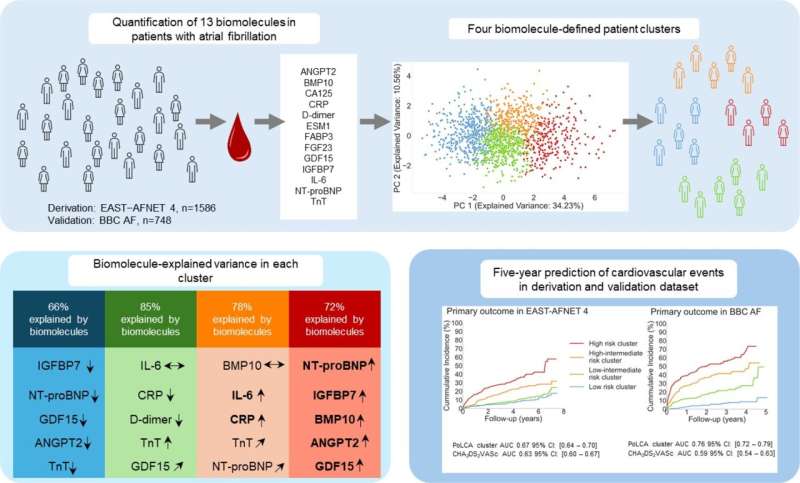This article has been reviewed according to Science X's editorial process and policies. Editors have highlighted the following attributes while ensuring the content's credibility:
fact-checked
peer-reviewed publication
proofread
Circulating biomolecules identify patients with atrial fibrillation at high risk of cardiovascular events

An analysis of the biomolecule substudy of the EAST–AFNET 4 trial has revealed that biomolecule concentrations in the blood of patients with atrial fibrillation can be used to identify patients at high and low cardiovascular risk. The findings were published in Cardiovascular Research.
Atrial Fibrillation (AF) is the most common arrhythmia in elderly people. AF often occurs in patients with cardiovascular comorbidities with shared disease mechanisms. Little is known about the disease processes leading to AF-related complications and their interactions in patients with AF.
The EAST–AFNET 4 (Early Treatment of Atrial Fibrillation for Stroke Prevention) trial demonstrated that early rhythm control—with antiarrhythmic drugs or atrial fibrillation ablation—delivered within one year after AF diagnosis improves outcomes in 2,789 patients with early AF and cardiovascular risk factors compared to usual care (UC) over a 5-year follow-up time. A series of sub-analyses of the EAST–AFNET 4 data set verified the results for different sub-groups.
This substudy tested whether circulating biomolecules can be used to measure AF related disease processes and their interactions in patients and how they relate to stroke, heart failure, acute coronary syndrome, and cardiovascular death.
Paulus Kirchhof, principal investigator of EAST–AFNET 4 and author on the paper, explained, "We were fortunate that we precisely could quantify thirteen biomolecules related to different disease processes in the EAST–AFNET 4 biomolecule study.
"Clustering methods capturing interactions between biomolecules were applied to identify patients at risk of cardiovascular events based on biomolecule concentrations. Thereby, four AF subphenotypes with distinct biomolecule profiles and risk of complications were identified. The results provide insights into the drivers of AF-related complications in patients."
The prespecified analysis of the EAST–AFNET4 biomolecule study assigned 1,586 patients (71 years old, 46% women) into four clusters based on blood concentrations of 13 precisely-quantified biomolecules. These biomarkers potentially reflect aging, cardiac fibrosis, metabolic dysfunction, oxidative stress, cardiac load, endothelial dysfunction, and inflammation.
In each patient cluster, rates of cardiovascular death, stroke, or hospitalization for heart failure or acute coronary syndrome were calculated and compared between clusters over median 5.1 years follow-up. Findings were independently validated in a prospective cohort of 748 patients with AF (BBC-AF; median follow up 2.9 years).
The highest-risk patient cluster mainly showed cardiometabolic disturbances, with elevated concentrations of the biomolecules BMP10, IGFBP7, NT-proBNP, ANGPT2 and GDF15. Patients in the lowest-risk cluster showed low concentrations of these biomolecules.
Two intermediate-risk clusters differed by high or low concentrations of hsCRP, IL-6, and D-dimer. Patients in the highest-risk cluster had a 5-fold higher cardiovascular event rate than patients in the low-risk cluster. Early rhythm control therapy was effective across clusters.
Prof. Fabritz concluded, "The EAST–AFNET 4 biomolecule study showed [that] biomolecule concentrations identify cardiometabolic subtypes in patients with atrial fibrillation at high and low cardiovascular risk. Biomolecule-based patient clusters can be used to advance management of atrial fibrillation.
"Our findings call for future research into the effects of biomolecules on cardiovascular function. These patient clusters open new treatment options in each cluster, enabling research testing the effectiveness in patients with specific subphenotypes."
More information: Larissa Fabritz et al, Blood-based cardiometabolic phenotypes in atrial fibrillation and their associated risk: EAST-AFNET 4 biomolecule study, Cardiovascular Research (2024). DOI: 10.1093/cvr/cvae067


















